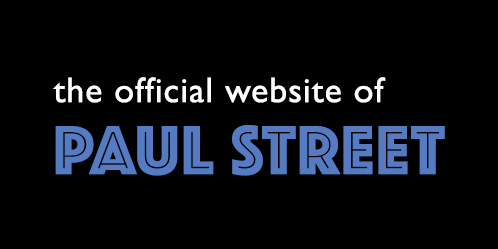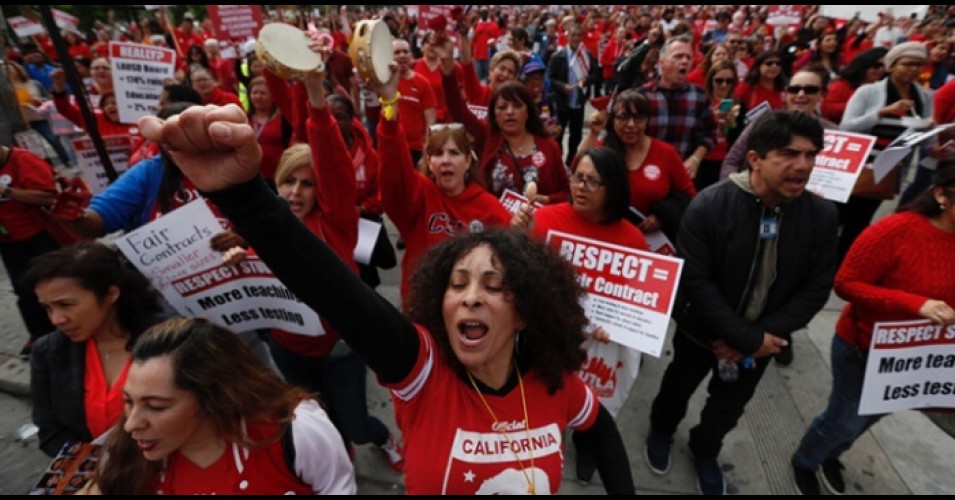Truthdig, February 6, 2019 Let’s be brutally honest and unsentimental: There are few, if any, serious prospects for attaining the transformative change we need through the current United States elections and party system.
Yes, Donald Trump’s approval rating has dipped back down into the 30s (thanks to his shutdown madness), the Democrats have control of the House, and a handful of Democratic presidential candidates seem to be embracing progressive ideas like “Medicare for all.”
But, at risk of sounding rude, so what? Even before they took up their new House majority, the dismal, dollar-drenched establishment Democrats killed Alexandria Ocasio-Cortez’s urgent call for the lower chamber of Congress to commit to the “Green New Deal.” Never mind that fossil fuel-driven global warming is the biggest issue of our or any time, turning the planet into a giant greenhouse-gas chamber. Or that the Green New Deal is a great big, juicy twofer: a major good-job-creation program that would enlist millions of working people in saving livable ecology and thereby help avert the extinction of the human species.
The Democratic Party presidential candidates talking progressive just mean they understand the ruse: You can’t win and cash in on years of “public service” to private interests without pretending to be something you aren’t. The late author Christopher Hitchens usefully described “the essence of American politics” as “the manipulation of populism by elitism.” Hitchens wrote in his study of the corporate-neoliberal Bill Clinton presidency:
“That elite is most successful which can claim the heartiest allegiance of the fickle crowd; can present itself as most ‘in touch’ with popular concerns; can anticipate the tides and pulses of public opinion; can, in short, be the least apparently ‘elitist’ … but the smarter elite managers have learned … that solid, measurable pledges have to be distinguished by a reserve tag that earmarks them for the bankrollers and backers.”
This could set the stage for a new, arch-reactionary, faux-populist Republican Congress and presidency. Popular resentment abhors a progressive vacuum orchestrated by arrogant liberal elites (the “adults in the room”) captive to big capital.
“The Democrats,” historian Terry Thomas told me in an email, “want to sit around and act like we’ve got this covered because we’re sane and Dumpster’s [Trump’s] not, our point has been proven, so now just give us power again, and we’ll put everything back together, nothing more needed. … No need for radical change, just put the adults back in. How insulting: the adults were in the room — by their estimation Obama was the epitome of adulthood — and it produced this.”
Bernie Sanders 2020? He will likely (but maybe not!) be pushed to the margins of the field with help from a “liberal” corporate media that will harp on his age and supposedly “extreme” positions. That media and the public relations industry will further sideline him by fixating, as usual, on superficial matters of candidate character and selling the “contenders” like brands of toothpaste and pushing policy to the margins of discussion.
Impeachment? Wait for Mueller Time, but don’t hold your breath. The Democrats actually want to keep Trump around to run against in 2020. They worry that impeachment (which requires a two-thirds vote in the Republican-controlled Senate) without removal could enhance his chances for re-election.
Is there a quick way out of this madness? No. The reigning, corporate-managed and binary party and electoral systems are still hegemonic. The horror of Trump helps make it so for the next election cycle.
But that’s no reason to give up on progressive change. It’s understandable that millions of Americans are going to get pulled along into an “anybody but Trump” fever. He’s a malignant narcissist and creeping ecocidal fascist. Nobody to the left and human side of the white-nationalist-harboring Republican Party could possibly want him to get a second term.
At the same time, it will be tactically useful for the left if Democrats own the stink of the very system that owns them come 2021. The “inauthentic opposition” (as the late political scientist Sheldon Wolin aptly labeled the Democrats) gets to masquerade as a people’s party—and to sell major (i.e., capitalist) party politics—most effectively when it is out of office. It is most clearly exposed as inadequate, and as a party beholden to capital, when it holds nominal power.
Meanwhile, over time, signs and models of real popular resistance have emerged from beyond the quadrennial electoral extravaganza that is sold to us as “politics”—the only politics that matters. Examples include: the inspiring fights many rural, red state communities undertook against federal immigration raids in 2017 and 2018; the successful strikes teachers unions (most recently in Los Angeles) have fought on behalf of public education; public sector unions’ successful fight against a right-wing Supreme Court decision meant to wipe out their membership base; and airport and airline workers’ recent halting of Trump’s ridiculous government shutdown through the exercise of their strategic workplace capacity to idle capital and disrupt profits. Sara Nelson, the fiery head of the flight attendants union, called during the shutdown for a “national general strike.” American yellow vests, anyone?
Organic rank-and-file labor activity is on the rise. I recently attended a workers town hall organized by the Democratic Socialists of America in Chicago. A community college instructor, three nurses, a music teacher, a teamster, a charter-school teacher and a federal government worker told harrowing and inspiring stories of their struggles to form unions and win contracts from arrogant employers who treat their workers “like commodities” at the expense of both their employees and the public they claim to serve. The federal worker spoke movingly of how the air-traffic controllers forced Trump’s hand and helped “awaken the sleeping giant of worker power.”
Could this growing working class insurgency beneath the headlines take a meaningfully independent electoral form beyond the reach of capital? Yes, with time—and with smart, patient local organizing.
A new movement for a real people’s party is forming in the U.S. Led by a group of young former Sanders staffers, who learned from experience that the Democrats offer a hopelessly flawed vehicle, the Movement for a People’s Party (MPP) stakes its hopes not on national candidates and celebrities but rather on grassroots organizing that connects the labor movement to local communities around issues that matter to everyday working people.
The heart and soul of the MPP is its Labor Community Campaign for an Independent Politics (LCCIP), an effort to put real organizing meat on the bones of two resolutions passed at the 2017 AFL-CIO Convention. “Whether the candidates are elected from the Republican or Democratic Party,” the first resolution stated, “the interests of Wall Street have been protected and advanced, while the interests of labor and working people have generally been set back.” The second resolution concluded that “the time has passed when we can passively settle for the lesser of two evils politics.”
Moving seriously on that language to make it more than just noise means connecting with working people on the jobs and in the communities where they live. As LCCIP endorser Chris Silvera, the secretary-treasurer of Teamsters Local 808 in Long Island City, N.Y., told me last week, “We need to start small, where people work and live. We need to build up from where we can actually win: city council, then maybe mayoral, then gubernatorial.” Silva added that “a desperate working-class” doesn’t have the resources to decide presidential campaigns in which “even the loser spends half a billion dollars” (or congressional campaigns that run through millions). Working people don’t have the time and energy to follow the bouncing ball of “Russiagate” or the latest presidential town hall in Des Moines. They do have time and energy for backing local and state candidates who advocate for working people and communities on issues directly relevant to their lives.
Another LCCIP advocate is Nancy Wohlforth, a former member of the AFL-CIO executive board who describes herself as one of labor’s “notorious third-party activists.” While she expressed to me cautious respect for likely Democratic presidential candidate Sherrod Brown (a longstanding union ally)as well as Sanders, Wohlforth said she thinks the presidential spectacle is out of play for progressives because “everyone” is understandably “on the bandwagon to get rid of Trump.” But on a local level, she said, “We can have some movement.”
Wohlforth cited the example of Richmond, Calif., where union activists affiliated with the Richmond Progressive Alliance, an independent political organization that united left-leaning activists across party lines, beat back the city’s corporate giant—Chevron—to win a solid City Council majority and the mayoralty. The progressive city government forced huge tax payments from Chevron, limited pollution, raised the minimum wage to $15 an hour, passed rent control, implemented numerous green measures and established Richmond as an immigrant-friendly sanctuary city.
LCCIP sponsor Donna Dewitt is former chair of the South Carolina AFL-CIO and current chair of the South Carolina Labor Party. While she retains hope for a second Sanders run, she said she has little interest in the presidential candidate circus atop the Democratic Party. Instead, she dedicates her energies to fighting on local and state issues and finding working-class progressives to run for electable offices.
How long before a real labor- and community-based 21st century people’s party could run viable candidates and win races for national office, including the presidency? Silvera told me that’s roughly 10 years out. MPP founder Nick Brana offered a shorter time frame. He told me late last year that the likely upcoming rigging of the 2020 Democratic primaries against Sanders and the overdue onset of the next Wall Street-crafted Great Recession could open big space for such candidates in 2024.
But who knows? It’s not about the crystal ball. Rather, it’s about many-sided organizing and building out from the bottom up to create a powerful grassroots movement that connects local community and workplace activism to the broader political economy to address interrelated national and global crises of democracy, inequality, human and civil rights, peace and (last but not least) livable ecology.
It’s also about building on the great leftist intellectual Noam Chomsky’s warning about what a Sanders presidency would have faced in 2017:
“His campaign … [was] a break with over a century of American political history. No corporate support, no financial wealth, he was unknown, no media support. The media simply either ignored or denigrated him. And he came pretty close—he probably could have won the nomination, maybe the election. But suppose he’d been elected. He couldn’t have done a thing. Nobody in Congress, no governors, no legislatures, none of the big economic powers, which have an enormous effect on policy. All opposed to him. In order for him to do anything, he would have to have a substantial, functioning party apparatus, which would have to grow from the grass roots. It would have to be locally organized, it would have to operate at local levels, state levels, Congress, the bureaucracy—you have to build the whole system from the bottom.” [emphasis added]
This is a key and commonly underestimated point. A grassroots people’s movement and politics can’t just be just about electing progressive-populist candidates. It must also be about defending leftist politicians against capitalist and broader right-wing reaction after they gain office.

